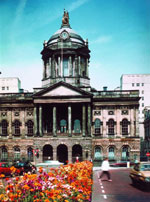
Liverpool city hall built between 1749 and 1820

FRONT PAGE
About us
 

City Halls: Europe
| Aachen | Antwerp | Athens | Berlin | Birmingham | Bolton | Bradford | Bremen | Brighton | Cardiff | Cologne | Cork | Dresden | Florence | Glasgow | Hanover | Innsbruck | Jena | Leeds | Liverpool | London | Manchester | Moscow | Munich | Neuss | Paris | Sheffield | Southampton | Stockholm | Stuttgart | The Hague | Vienna |
City Halls: The Americas
| Bogota | Boston | Buenos Aires | Chicago | Houston | New York | Philadelphia | Pittsburgh | San Francisco | Seattle | Toronto | Vancouver |
City Halls: Asia + Australasia
| Ekaterinburg | Sydney | Tokyo | Wellington |

Worldwide | Elections | North America | Latin America | Europe | Asia | Africa |



























|
|
Liverpool City Hall
By Gregor Gosciniak
30 March 2005: Liverpool's city hall (town hall), one of the oldest historical buildings in the City of Liverpool, is home to the city’s mayor. The present city hall is the third to have been built on or near the current site. The first city hall was built in 1515, the second one in 1673. Today’s city hall, first conceived in 1748 and completed in 1754, was re-built between 1795 and 1820. The dome, which is topped by the Roman goddess Minerva, was erected in 1802.
The council chamber was added to the building in 1811 and the ballroom, the last addition to the city hall, was opened In 1820. In 1775 the American War of Independence caused a depression in trade with New York and as a result sailors’ pay was cut. Sailors took to the streets, and riots occurred. At the height of the riots, some 50 ships were anchored in the Mersey River and a ship’s cannon was used to attack the city hall – albeit without success.
Some 20 years later, after having survived the riots, a fire destroyed much of the building. But by that time the city hall had become such a vital part of city life that the authorities immediately planned for its rebuilding and commissioned the well known London architect James Wyatt with the design of a new civic centre.
At the outbreak of the Second World War, Liverpool City Council took the precaution to remove to safety much of the city hall’s collection of treasures. Although the Nazi-Germany Blitz of 1941 destroyed large parts of Liverpool, the city hall survived. However, the council chamber and the ballroom were badly damaged. Restoration was immediately set in motion. Today, the city hall is one of the oldest and finest buildings in Liverpool.
The dome of the city hall is faced by four clocks, which are flanked by lions and unicorns. Minerva, on top of the dome, represents the Roman goddess of wisdom and protector of cities. Designed by Felix Rossi, Minerva is made of terracotta and covered In 87,000 square inches of gold leaf.
Along the south, east and west sides of the building are friezes depicting stone carvings of heads and animals, which represent Liverpool’s trading and nautical history. At the north end, four statues symbolise the four seasons. They were taken from the Irish parliament building in Dublin.
The north side also features the Queen’s Balcony, named after Queen Victoria who stood there in 1851 to greet the city’s merchants. The front balcony has always been used by members of the royal family, by both of the city’s Premiership football clubs, Liverpool FC and Everton FC and, in the 60s by the Beatles.
King Edward VII once described the city hall’s magnificent suite of rooms as being comparable to those of the Russian Czar’s Winter Palace in St Petersburg and as being ‘the best-proportioned in all Europe.’
The construction of the city hall was significantly funded by Liverpool businesses and entrepreneurs many of whom had benefited from the slave trade. In fact, sixteen of Liverpool’s Mayors are said to have been slave merchants. Three centuries of slave and other overseas trade created a city rich in people, culture, financial wealth and architecture. Much of it has survived to the present day.
Today, the City hall's beautiful interior provides a unique setting for a wide range of events and functions, such as weddings, parties and conferences.
The main rooms in the city hall are:
• the Main Ballroom
• the Small Ballroom
• the Dining room
• three Reception Rooms
• the Hall of Remembrance
• the Council Chamber
|
|

|


































